Barbara Latkowski
Caledonia Courier
Spring has sprung and so has the hummingbird population in Fort St. James.
As feeders fill yards, people can’t wait to catch a glimpse of these small and very quick creatures.
But are their feeders really ready? What is in the nectar recipe? And do you know all there is to know about these mysterious little fellows that visit every spring?
Hummingbirds are among the smallest of creatures. Found only in North, Central and South America, hummingbirds weigh less than an ounce, migrate great distances and are the only birds that can hover and fly backwards.
One common is the Rufous Hummingbird. They are the only male hummingbirds that are a rufous-brown and white with a red gorget. They arrive as early as March and stay until the end of August.
Hummingbirds have incredible memories. They are capable of remembering where flowers and feeders were found the previous year and then go to that exact same spot. If they don't find a feeder there yet, they will certainly let you know. So don't forget, hang your feeder just before your hummers are due to arrive.
Hummingbirds, especially Rufous, are very aggressive birds. They will claim as many feeders as possible and keep busy chasing away all other hummingbirds. If this happens to your yard, the best solution is to hang several feeders, making sure that the resident hummer cannot see all feeders at one time. This will allow other birds a chance to feed.
According to Wild Birds Unlimited, with so many feeders on the market, it can be confusing choosing one that works the best. The key is to choose one that can be cleaned easily and doesn't leak.
The best feeders are basin style. These feeders have a flat bottom and a top that simply lifts off - no crevices to trap old solution. Most are made from a durable, polycarbonate that resists fading from UV exposure, keeping its red colour that the hummingbirds love for years. A basin feeder will not leak and usually have perches for the birds to use while feeding. Studies have found that if a hummingbird can perch, they will feed longer (as long as they don't feel the need to constantly patrol every feeder!)
Cleanliness is extremely important when feeding hummingbirds.
Fermented nectar occurs when the solution sits too long in the feeders and this can be dangerous to hummers, harboring dangerous molds, mildew and toxins. Any hummer attempting to drink from these feeders will leave and possibly not return so it is important to remove any trace of fermented syrup or mildew before refilling.
To do this, use a port brush to get into the small openings and use a small amount of vinegar in hot soapy water to clean the entire feeder thoroughly. The vinegar will work just as well as bleach but without bleach's harmful side effects. Rinse well before hanging your feeder back out.
And don't forget about their food.
The sugar solution needs to be four parts water to one part white sugar in the summer. This concentration closely resembles the sucrose that hummingbirds find in the flowers they feed from. Any mixture that is a higher concentration than 3:1 can be dangerous for the small birds. If there is too much sugar, they will find it difficult to break it down in their bodies, leading to dehydration and possible kidney damage. Also, the heavy syrup that occurs in a thick mixture of sugar and water can coat their tongues and make it almost impossible for them to feed.
Hummingbird Facts (Wild Birds Unlimited)
- There are more than 300 species of hummingbirds of which only 4 are found here in the Fraser Valley.
- The ruby-throated hummingbird weighs less than one-tenth of an ounce.
- Hummingbirds can fly up to 45 miles per hour and their wings can beat up to 200 times per second.
- A hummingbirds heart beats 1260 times per minute and while resting takes 250 breaths per minute.
- Hummingbirds will consume half their weight in sugar each day from flowers and feeders. If human had the metabolism of a hummer, they would eat 285 lbs of hamburger a day.
- Hummingbirds can live up to 12 years although many only live 3 to 5 years.
